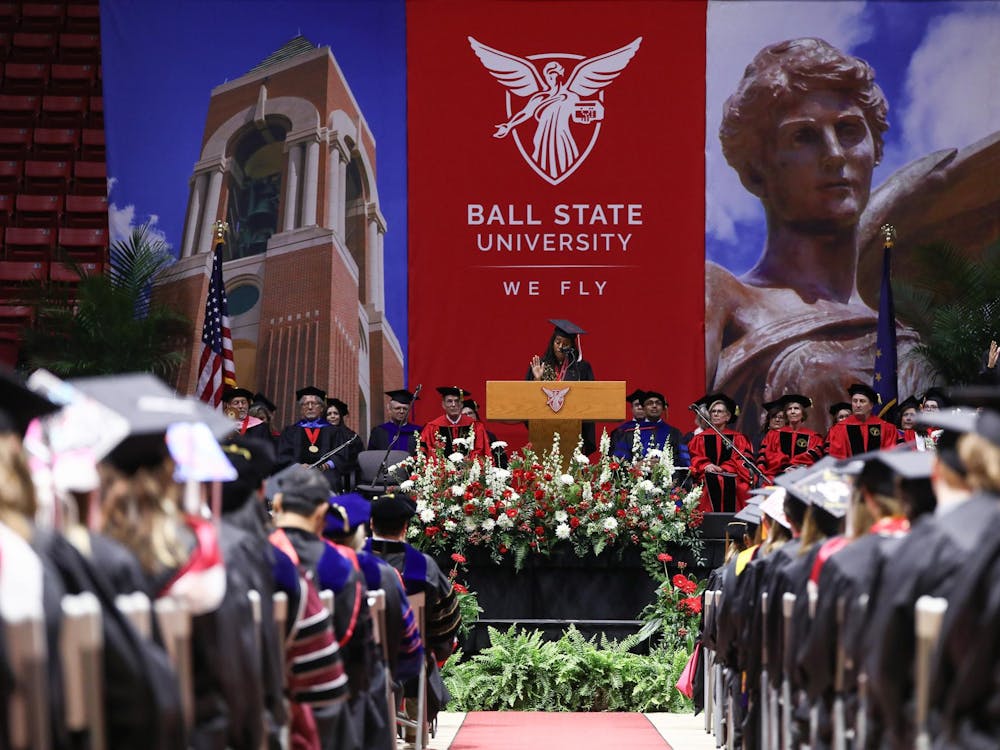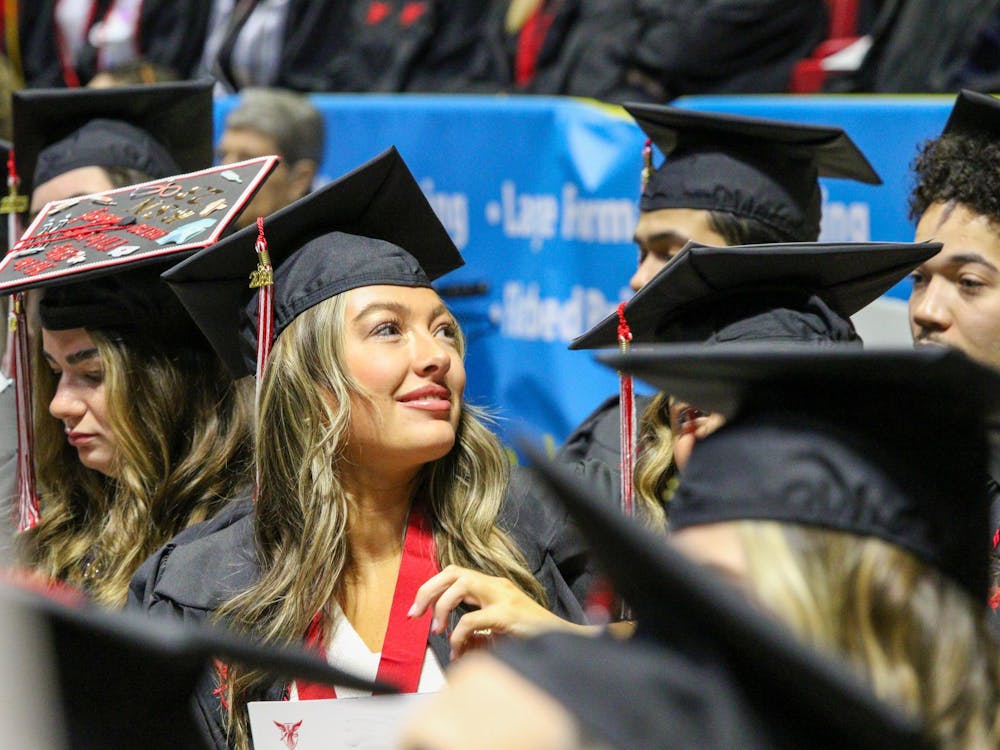Chairperson of the Department of Sociology Melinda Messineo gave three factors that could have contributed to the culture behind the actions of Oklahoma University's Sigma Alpha Epsilon chapter:
1. Cultural lag
This happens when a part of society doesn't change at the same rate as another, said Messineo. There is tension between tradition and changing values. In the case of SAE, the tradition was a racist chant. The chapter wasn't keeping up with the cultural expectations of what is considered appropriate.
2. Unawareness
Members of the chapter may be perpetuating detrimental cultural practices without actually knowing what they mean, said Messineo.
3. Privilege
A dominant group who is not regularly exposed to different groups of people could be acting insensitively without facing any opposition from others, said Messineo.
After a video was released of a racist chant by members of an Oklahoma University fraternity, Ball State Sociology Department Chairperson Melinda Messineo said there are several factors that contribute to the culture behind the members' actions.
She uses words like “cultural lag,” “unawareness” and “privilege,” but also has a few suggestions for how organizations like Sigma Alpha Epsilon, the fraternity that the members featured in the video belonged to, could combat the scrutiny stemming from the controversy.
One would be to publicly announce that the values presented in the video don’t apply to the actual values of the organization, she said. Her other recommendation is more extensive, but “powerful.”
She looks for actual efforts, programs and initiatives that the organization enacts “that are clearly counter to the values that are being expressed in [the SAE] incident.”
The national SAE chapter has denounced the behavior of the SAE members in the video, saying on its website that the actions featured in the video don’t mesh with SAE’s creed, “The True Gentleman.”
As for concrete efforts, SAE mentions a zero-tolerance policy it has for discrimination and cites its number of members who self-identify as a minority – 20 percent. It doesn’t, however, mention a specific diversity recruitment initiative within the fraternity.
Ball State’s SAE chapter didn’t respond to requests for an interview about its diversity initiatives.
Ball State’s Office of Institutional Diversity (OID) requires a diversity statement from each department, which can detail how they should celebrate diversity or increase diversity among students and faculty, but Ball State Greek Life leaves recruitment, including that of students with diverse backgrounds, up to individual chapters who may or may not have their own diversity policies.
Of the three Greek councils on Ball State's campus, two refused a request for an interview and provided a statement instead. The Interfraternity Council (IFC) and the Panhellenic Council (PHC) provided the same statement, which read that Ball State chapters seek members from diverse backgrounds; however, the statement did not give any examples of how chapters accomplished this. The Office of Student Life also doesn’t keep track of the number of non-white students in Ball State student organizations, including the PHC, IFC and the National Pan-Hellenic Council (NPHC).
Kari Murphy, the Associate Director of Student Life, said in an email that the Greek councils do not have a diversity policy.
This lack of a set system for recruitment of diverse students worries Messineo.
“A lot of this stuff isn’t malicious at all. It’s just structural,” she said.
If a conscious initiative to recruit diverse people has never existed, no one knows what would happen if it suddenly did, said Messineo.
“Would it be more interesting? Would you have a more engaged sorority or fraternity if you were trying harder? What would you learn from each other?” she said. “I think it’s an opportunity lost.”
Tony Thomas, a black member of Ball State's Phi Gamma Delta (FIJI) chapter, which includes several other non-white members, said FIJI doesn't seek out members based on diversity, but if he saw racism occur in Greek Life, he would take action.
"I would even tell my line about racism in other chapters because we actually want to be good men," he said. "I would want to fix it."
Thomas joined FIJI because he liked the chapter's values and felt like he would fit into a fraternity that contained several members with diverse backgrounds.
"They didn't give me a bid because I'd increase their diversity but because I fit in," he said.
In the last few years, OID has increased its efforts to promote diversity on campus, said Charlene Alexander, the associate provost for diversity at Ball State. Last year, Alexander began working with all units on campus to develop a diversity recruitment plan.
Messineo cheers the university's changing diversity initiative.
“It’s very active," she said. "We want to make a difference. We want greater representation. We want to celebrate diversity in these ways. It’s a very intentional, active approach to increasing diversity and celebrating diversity on campus.”
Messineo said diversity is at the forefront of the sociology department when they contemplate a new hire or design a curriculum.
She particularly praises an upcoming diversity workshop where faculty members discuss diversity issues such as race and gender. She said she thinks greek organizations might benefit from participating in these types of discussions.
"And what we've been doing in the past is just not talking about it. But what we are going to do now, is we're going to have a workshop to figure out, 'how do you talk about it?'" she said. "And it's going to be a hard conversation because everyone's so careful. No one wants to offend anybody, but what happens is it's silenced the conversation."
OID doesn’t directly work with student organizations, said Alexander, but the Multicultural Center works to facilitate some OID diversity initiatives in student organizations.
Still, Messineo said she thinks a situation like the one at Oklahoma University could develop at Ball State if groups don’t act with intention toward diversity.
Authentic relationships between groups of people can prevent this, said Messineo.
Raquel Myers, the president of NPHC, which houses the historically black fraternities and sororities on campus, said she has a close connection with the presidents of the IFC and the PHC, Dave Hammons and Caren Adelsperger, respectively.
“They’re always there when I have questions, when I need support,” Myers said.
The IFC represents member fraternities, including SAE, and the PHC represents member women’s sororities.
So far this semester, the NPHC has collaborated with the IFC and the PHC on a Valentine’s Day fundraiser and has begun work on an all-council event and the annual Meet the Greeks event.
This is a change from a few years ago, Myers said. She said she talks with the IFC and the PHC about "10 times as much" as previous presidents. She noticed the increase in collaboration last April.
When Myers plans collaborative events, she said she interacts with executive board members from different IFC and PHC chapters.
Last semester, former IFC president Andrew Sharp said the IFC, PHC and NPHC worked well together. He said he didn't know what collaboration was like between the organizations before he took office. He said there was no requirement in place that said the organizations had to work together.
He said he didn’t believe having regulated collaboration would be better.
“Anytime you make something mandatory, then it’s just something you have to do instead of something you want to do,” he said.
After Myers finishes her term as president of NPHC, she said she hopes to communicate to the new president the importance of collaboration between councils.
Change takes time, Messineo said. Diversity has gone through several changes: it’s been ignored, tolerated and now it’s celebrated.
Some places and organizations have transitioned faster than others, she said, but it’s still taken decades.
“The civil rights movement got us to [tolerate],” she said. “And now we’re getting to celebrating and seeing [diversity] as an asset. And that’s a path. It takes time. It takes time to shift organizations, but the organization has to decide they want to change.”
With initiatives like the ones being enacted by the Office of Institutional Diversity, Messineo thinks change in organizations like Oklahoma University's SAE chapter is possible.
Laura Arwood contributed to this article.




